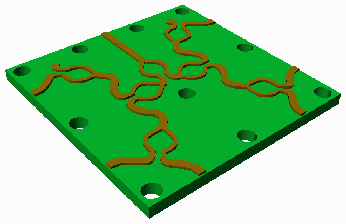Importing Gerber/DXF from PCB into SolidWorks

As the design of PCB's becomes more complex, the need to do 3D modeling of a printed circuit board also becomes more important. Many PCB design tools have an interface to SolidWorks via the IDF file format -- however this approach is useful mostly for components, connectors, board outline and mounting holes. If you need conductor and plated through hole data in 3D, IDF is not a good solution. And, of course, if your PCB layout tool does not support IDF you are out of luck.
AutoCAD DXF?
An initial thought is to use SolidWorks ability to import AutoCAD's DWG/DXF format as a way to move the board data into SolidWorks. For example, it is pretty easy to convert most Gerber files into DXF. However those that have tried this have found it does not work as well as one would hope.
Issues?
Polylines with width not supported - SolidWorks doesn't read the width of the polyline (this may have changed in recent versions of SW) so if you are using polylines with width in AutoCAD to represent traces you lose them.
Layers not Supported - most PCBs have multiple layers and you want the conductors on each layer to stay on the layer. If you try to import multiple layers into solidworks you'll find that they all get mushed together.
Manual Extrusions - You'll have to manually select the lines/arcs and extrude them to get a "part" in Solidworks. While this is not a problem for a few pieces, a large PCB makes this quite aggravating.
No Z Data - assuming you have a "stack" of conductor and dielectric layers, you have to import them one at time and then assemble them. Again, very time consuming.
Material Properties - it would be nice if you could pass the fact that your conductors are copper and that your board is FR4 (or alumina or whatever material) but these attributes have to be attached manually.
Examples of DXF into SolidWorks
It might be worthwhile to actually demonstrate some of these issues mentioned above. We are going to run two experiments: Gerber to DXF using a standard converter and Gerber to DXF using Artworks GBRUNION. What is the difference?
|
GBR2DXF
round pads to circles in DXF draws to polylines with width no support for negative or paint/scratch layer operations supports multiple layers no understanding of drill holes no understanding of stackup position |
GBRUNion
can recover arcs and circles support for negative or paint/scratch layer operations supports multiple layers no understanding of drill holes no understanding of stackup position |
Here is the set of Gerber Files we are going to use for our demo

The red layer is the top.gbr, the green layer is the bottom.gbr, the blue layer is an inner power/ground (drawn in reverse as is typical for such layers) and the yellow layer represents the drill data which runs all the way through the board. A magenta layer is hardly visible but contains the board outline. You can download the set of Gerber files as solidworks_gerber.zip
